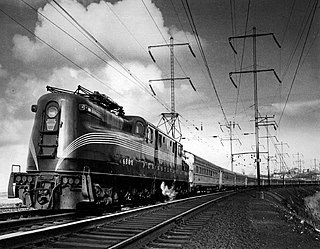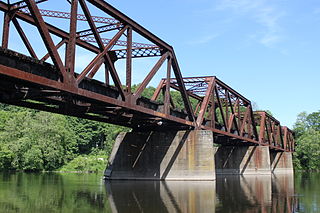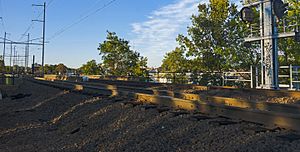
The Pennsylvania Railroad GG1 is a class of streamlined electric locomotives built for the Pennsylvania Railroad (PRR), in the northeastern United States. The class was known for its striking art deco shell, its ability to pull trains at up to 100 mph, and its long operating career of almost 50 years.

The Pennsylvania-Reading Seashore Lines was a railroad that operated in South Jersey in the 20th century. It was created in 1933 as a joint consolidation venture between two competing railroads in the region: the Pennsylvania Railroad and the Reading Company.
The Federal Express was an overnight named passenger train run by the Pennsylvania Railroad and the New York, New Haven and Hartford Railroad between Washington, DC's Union Station and Boston, Massachusetts's South Station from 1912 to 1971. At different times, its route has taken it across the Hudson River via a car float between Port Morris and Jersey City, the Poughkeepsie Bridge, and finally the Pennsylvania Tunnel and Terminal Railroad. The final routing was identical to today's high-speed Northeast Corridor.

The Lackawanna Cut-Off was a rail line built by the Delaware, Lackawanna and Western Railroad (DL&W). Constructed from 1908 to 1911, the line was part of a 396-mile (637 km) main line between Hoboken, New Jersey, and Buffalo, New York. It ran west for 28.45 miles (45.79 km) from Port Morris Junction in Port Morris, New Jersey, near the south end of Lake Hopatcong about 45 miles (72 km) west-northwest of New York City, to Slateford Junction in Slateford, Pennsylvania near the Delaware Water Gap.

The Lackawanna Old Road was part of the original mainline of the Delaware, Lackawanna & Western Railroad (DL&W). Opened in 1856, it was, for a half-century, a part of the line connecting the states of New Jersey and Pennsylvania.

Frankford Junction is a railroad junction, and former junction station, located on the border between the Harrowgate neighborhood of Philadelphia and Frankford, Philadelphia. At the junction, the 4-track Northeast Corridor line from Trenton connects with the 2-track Atlantic City Line from Atlantic City in the northeastern portion of Philadelphia about 2.9 miles (4.7 km) northeast of North Philadelphia station. It lies near the intersection of Frankford Avenue and Butler Street, to the west of the interchange between Interstate 95 and the approach to the Betsy Ross Bridge. It has been used for rail transportation since 1832 but has not served as a station since October 4, 1992.

Pennsylvania Railroad 4876 was a GG1-class electric locomotive built in January 1939 at the PRR's Altoona Works in Altoona, Pennsylvania, United States. It is best known for being involved in an accident on January 15, 1953, when the locomotive overran a buffer stop, crashed into the concourse of Union Station in Washington, D.C., and fell partway into the basement after the train's brakes failed. Due to the major crowds expected for the upcoming inauguration of Dwight D. Eisenhower, 4876 was lowered the rest of the way into the basement and a temporary floor was erected overhead. After the inauguration, the locomotive's frame and superstructure was essentially scrapped on site, with all the reusable components shipped back to Altoona, Pennsylvania, to reconstruct a replacement 4876, which operated for another 30 years.
The Frankford Junction train wreck occurred on September 6, 1943, when Pennsylvania Railroad's premier train, the Congressional Limited, crashed at Frankford Junction in the Kensington neighborhood of Philadelphia, Pennsylvania in the United States, killing 79 people and injuring 117 others.

The Rockport train wreck occurred in Rockport in Mansfield Township, New Jersey, United States, about three miles outside of Hackettstown, on June 16, 1925. A violent storm washed debris onto a grade crossing, derailing a Lackawanna Railroad (DL&W) train. The crash killed 42 passengers and five crewmen and injured twenty-three others.

The 1953 Pennsylvania Railroad train wreck occurred on January 15, 1953, when a passenger and mail train from Boston to Washington DC failed to brake sufficiently on its approach to Union Station, Washington, jumping the platform and plunging through the floor of the concourse. There were no deaths, but 43 people were injured.

The 2015 Philadelphia train derailment of a New York City-bound Amtrak train in Kensington, Philadelphia, Pennsylvania in the United States resulted in multiple passenger injuries and deaths and disrupted Amtrak service for several days afterward due to the resulting investigation and removal of the wrecked train cars.










